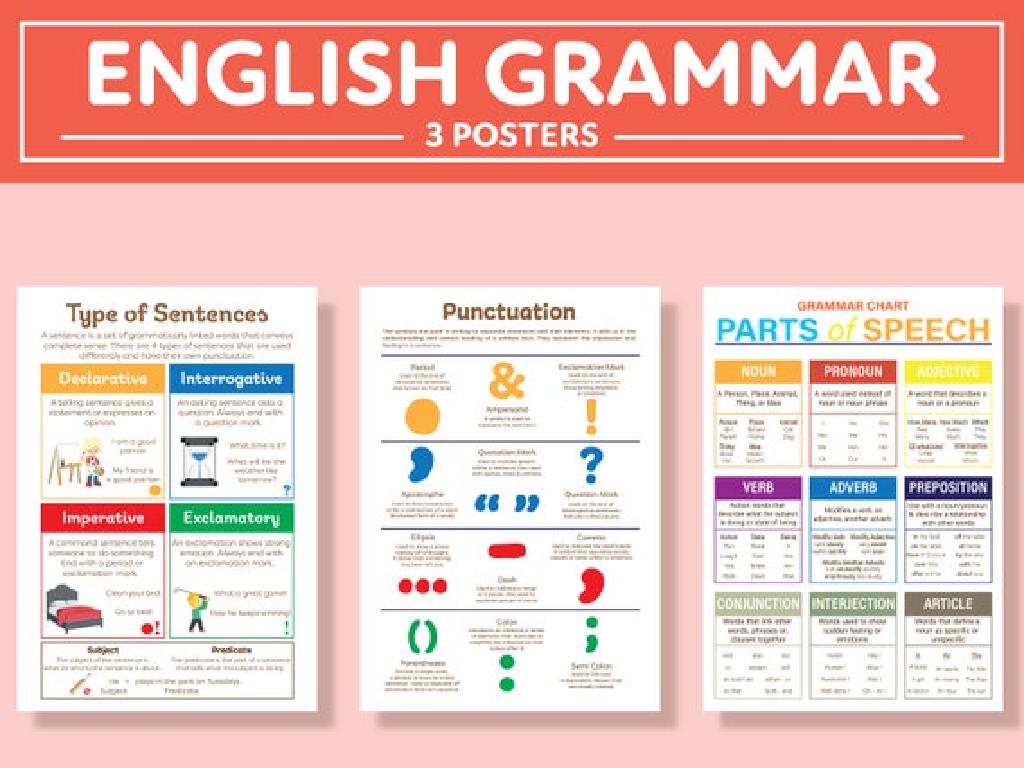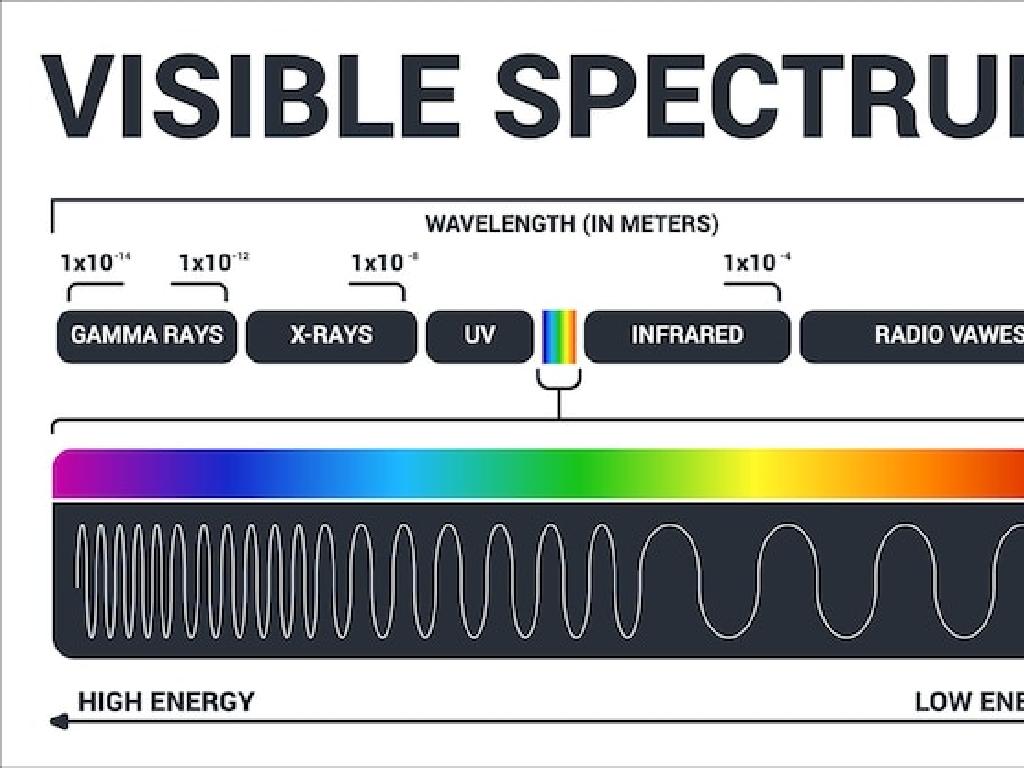Choose The Correct Digraph
Subject: Language arts
Grade: Kindergarten
Topic: Consonant Blends And Digraphs
Please LOG IN to download the presentation. Access is available to registered users only.
View More Content
Welcome to Digraphs!
– Digraphs: Special letter friends
– Like ‘sh’ in ship or ‘ch’ in chair
– Two letters make one sound
– Can you think of a digraph?
– Examples: ‘sh’, ‘ch’, ‘th’, ‘wh’
– Everyday digraph examples
– ‘sh’ as in sheep, ‘ch’ as in cheese
|
This slide introduces the concept of digraphs to Kindergarten students. Digraphs are pairs of letters that come together to produce a single sound, distinct from the sounds of each letter on its own. Start by explaining the term ‘digraph’ with simple language and examples. Encourage the children to think of examples of digraphs they may have encountered in words. Provide common examples of digraphs and use everyday words that the students are likely to know. This will help them connect the concept to their daily experiences. During the lesson, engage the students by asking them to come up with words that contain these digraphs and practice pronouncing them together.
Learning About Digraphs
– What’s a digraph?
– It’s when two letters make one sound like ‘sh’ in ‘ship’
– Two letters, one new sound
– Digraphs are special
– They don’t sound like their letters alone
– Examples: ‘ch’, ‘sh’, ‘th’, ‘wh’
– ‘ch’ as in ‘chair’, ‘sh’ as in ‘fish’, ‘th’ as in ‘three’, ‘wh’ as in ‘whale’
|
Introduce the concept of digraphs to the students by explaining that a digraph is a pair of letters that come together to create a single, new sound. Emphasize that this sound is different from the sounds of the letters when they are by themselves. Use common examples like ‘ch’, ‘sh’, ‘th’, and ‘wh’ to illustrate the concept. Show them how ‘ch’ makes a unique sound in ‘chair’ that is different from ‘c’ in ‘cat’ or ‘h’ in ‘hat’. Encourage the students to think of other words they know that contain these digraphs. You can also use visual aids or props to help them associate the digraphs with the sounds they make.
Meet the Digraphs!
– ‘ch’ like in ‘chair’
– ‘ch’ makes a sound like a train: choo-choo!
– ‘sh’ like in ‘shell’
– ‘sh’ is the sound we make when we’re quiet: shh!
– ‘th’ like in ‘thumb’
– ‘th’ is like sticking out your tongue lightly: th-th!
– ‘wh’ like in ‘whale’
– ‘wh’ starts like blowing a soft whistle: whoo!
|
This slide introduces the concept of digraphs to Kindergarten students, focusing on the sounds ‘ch’, ‘sh’, ‘th’, and ‘wh’. Each digraph is paired with a familiar word and a simple, relatable sound or action to help students remember. Encourage the children to mimic the sounds and actions. For example, they can pretend to be a train for ‘ch’, put a finger to their lips for ‘sh’, stick out their tongue for ‘th’, and pretend to blow a whistle for ‘wh’. These associations will help them recognize and pronounce these digraphs when they encounter them in words.
Listening for Digraphs
– Learn about digraph sounds
– Two letters make one sound, like ‘sh’ in ‘ship’
– Listen to the teacher’s words
– Identify the digraph in each word
– Do ‘chip’, ‘shop’, ‘bath’, ‘when’ have digraphs?
– Practice with example words
– ‘chip’ (ch), ‘shop’ (sh), ‘bath’ (th), ‘when’ (wh)
|
This slide is designed to help students recognize and understand digraphs, which are pairs of letters that create a single sound. Start by explaining what a digraph is and provide examples. Then, pronounce words clearly and ask students to listen for the digraph sounds. For the practice words, say each one aloud and have the students identify the digraph. Encourage them to repeat the words after you. This activity will help students to connect the sounds to the letters and improve their phonetic skills. Make sure to praise their efforts and correct gently, providing the right answers and encouraging them to try again.
Digraph Matching Game
– Match digraphs to pictures
– Say words aloud when matching
– Listen for the digraph sounds
– ‘ch’ as in ‘chair’, ‘sh’ as in ‘ship’
– Can you find the digraph?
– Is the ‘sh’ sound in ‘fish’? Yes!
|
This slide introduces a fun matching game to help Kindergarten students recognize and learn digraphs, which are pairs of letters that create a single sound, such as ‘sh’, ‘ch’, ‘th’, and ‘wh’. The activity involves matching digraphs to corresponding pictures and saying the words out loud to reinforce the connection between the visual and auditory elements of the digraphs. Encourage students to listen carefully to the sounds they make and identify the digraph within the word. This interactive approach helps solidify their understanding of digraphs in a playful and engaging manner. Prepare a set of cards with pictures and digraphs for the activity, and guide the students through several examples as a group before letting them try individually or in pairs.
Choosing the Right Digraph
– Help complete words with digraphs
– Pick the correct digraph for words
– Understand ‘_at’ can be ‘chat’ or ‘that’
– ‘ch’ makes a ‘ch’ sound as in ‘chop’, while ‘th’ sounds like ‘th’ in ‘this’
– Learn to choose the right word
– Practice with different examples to learn
|
This slide is designed to engage Kindergarten students in understanding and choosing the correct digraphs to complete words. Start by explaining what digraphs are: two letters that make one sound, like ‘ch’ in ‘chat’ or ‘th’ in ‘that’. Present the students with incomplete words and guide them to choose the correct digraph to fill in the blanks. Use visual aids and phonetic pronunciation to help them distinguish between the sounds. Encourage them to think about the meaning of the words to determine which one is correct. For example, ‘_at’ can be ‘chat’ (a talk) or ‘that’ (pointing out something), and context will help decide the right word. Provide plenty of examples and allow the students to practice with guidance.
Digraph Detective Activity
– Become a digraph detective!
– Find classroom items with digraphs
– Look for ‘ch’, ‘sh’, ‘th’, ‘wh’ in item names
– Share your findings with the class
– Listen to friends’ digraph discoveries
– Take turns and learn from others
|
This slide introduces an interactive class activity aimed at helping Kindergarten students recognize and understand digraphs two letters that make one sound. Encourage the children to search for objects in the classroom that contain digraph sounds such as ‘ch’, ‘sh’, ‘th’, and ‘wh’. Once they find an item, they should note it down. After the search, each student will have a chance to share their findings with the class, enhancing their speaking and listening skills. As a teacher, prepare to guide them through the activity, assist in identifying digraphs, and ensure every child participates. Possible items could be a ‘chair’, ‘shell’, ‘thumb’, or ‘whale’ (in a picture or book). This activity fosters peer learning as students listen to the discoveries of their classmates.
Let’s Practice Writing Digraphs!
– Trace ‘ch’, ‘sh’, ‘th’, ‘wh’
– Follow the dotted lines for ‘ch’, ‘sh’, ‘th’, ‘wh’
– Practice writing digraphs
– Write the digraphs on your own
– Remember letter shapes
– Notice how the letters form a team
– Share your writing with the class
|
This slide is for a classroom activity focused on writing practice for digraphs. Students will first trace the digraphs ‘ch’, ‘sh’, ‘th’, ‘wh’ on their worksheets to get familiar with the movements. After tracing, they should try to write the digraphs on their own, reinforcing their memory of the shapes and how the letters combine to form a single sound. Remind students that these letter combinations work together as a team to create unique sounds in words. Encourage them to pay close attention to the shape of the letters as they practice. After the writing activity, have students share their work with the class to build confidence and celebrate their learning.
Class Activity: Digraph Bingo!
– Let’s play Digraph Bingo together
– Listen for words with digraphs
– Digraphs are two letters making one sound, like ‘sh’ in ‘fish’
– Cover the digraph on your bingo card
– Shout ‘Bingo!’ when all are covered
|
This interactive activity is designed to help Kindergarten students recognize and learn digraphs, which are pairs of letters that create a single sound. Before starting, ensure each student has a bingo card with various digraphs (e.g., sh, ch, th, wh). Play sounds or say words that contain these digraphs and have the students cover the correct digraph on their cards. The first student to cover all their digraphs should yell ‘Bingo!’ and win the game. Possible variations of the game could include using pictures instead of words, having students come up with their own words that contain the digraphs, or playing in small groups. This activity will reinforce their understanding of digraphs in a fun and engaging way.
Review and Farewell: Digraph Discoveries
– Recap on digraphs
– Digraphs are two letters making one sound, like ‘sh’ in ‘ship’.
– Words with digraphs
– Examples: ‘ch’ in ‘chair’, ‘th’ in ‘thumb’, ‘wh’ in ‘whale’.
– Praise for today’s work
– Looking forward to next class
|
As we conclude today’s lesson, it’s important to review what we’ve learned about digraphs. Ask the students to recall the concept of digraphs and to provide examples of words that include them. This reinforces their understanding and helps with retention. Acknowledge their hard work and progress in today’s class, and express enthusiasm for the next lesson to maintain their interest and excitement about learning. Prepare a list of digraph words for students to take home and practice, and consider sending a note to parents about today’s lesson so they can reinforce the concept at home.






